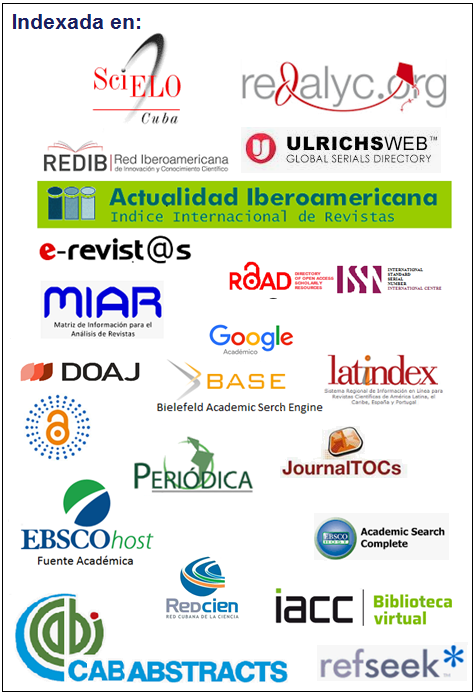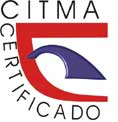Mathematical modeling of Ni-lateritic ore drying in a rotary cylindrical kiln on a semi-industrial scale
Keywords:
mathematical modeling, thermal drying, lateritic Ni-ore, rotating horizontal cylinder, energy balanceAbstract
The lack of knowledge about the relationship between variables that characterize the thermal drying process prevents reaching the required moisture values in the Ni-lateritic ore at the exit of the rotating horizontal cylinder on a semi-industrial scale, with lowest possible fuel consumption and least impact on environment. For this reason, a steady state phenomenological model was established. This model consists of a system of differential equations and ordinary equations obtained from the mass and energy balances in the Ni-laterites ore, in the gas and in the wall of the dryer. Besides, from the bond equations that allow obtaining the thermophysical properties of the Ni-ore laterites and gases and the heat and mass transfer coefficients involved in the process, solved by using the fourth order Runger-Kutta numerical method. This model allows establishing the distribution temperature behavior of the gas, the Ni-laterites ore and the variation of moisture of the last one along the entire cylinder length.Downloads
References
Abbasfard, H.; Rafsanjani, H. H.; Ghader, S. and Ghanbari, M. 2013: Mathematical modeling and simulation of an industrial rotary dryer: a case study of ammonium nitrate plant. Powder technology, 239: 499-505.
Agustini, S. S. 2006: Regenerative action of the wall on the heat transfer for directly and indirectly heated rotary kilns. Doctoral thesis. Universität Magdeburg.
Arruda, E. B. 2008: Comparison of the performance of the roto-fluidized dryer and conventional rotary dryer. Federal University of Uberlândia.
Cao, W. F. and Langrish, T. A. G. 2000: The development and validation of a system model for a countercurrent cascading rotary dryer. Drying Technology, 18(1-2): 99-115.
Castaño, L. F.; Rubio, F. R. y Ortega, M. G. 2009: Modelado de secaderos rotatorios en isocorriente. Revista Iberoamericana de automática e informática industrial, 6(4): 32-43.
Douglas, P. L.; Kwade, A.; Lee, P. L. and Mallick, S. K. 1993: Simulation of a rotary dryer for sugar crystalline. Drying Technology, 11(1): 129-155.
Echeeri, A. and Maalmi, M. 2021: Performance evaluation of a rotary dryer in both co-current and counter-current configurations. Journal of Thermal Engineering, 7(14): 1945-1957.
Froment, G. F. and Bischoff, K. B. 1990: Chemical Reactor Analysis and Design. New York: John Wiley & Sons.
Gorog, J. P.; Adams, T. N. and Brimacombe, J. K. 1982: Regenerative heat transfer in rotary kilns. Metallurgical transactions B, 13: 153-163.
Goyal, A. and Bushra, A. 2018: Modelling and Simulation of Rotary Dryer for Wheat drying. Journal of Postharvest Technology, 6(1): 63-68.
Harriot, W. L. M. J. C. S. P. 2007. Operaciones unitarias en ingeniería química. 7ma ed. México D. F.: Mcgraw-Hill/Interamericana. ISBN 13: 978-970-10-6174-9.
Mujumdar, K. S.; Ganesh, K. V. and Kulkarni, S. B. 2007: Rotary Cement Kiln Simulator (RoCKS): Integrated Modeling of Pre-Heater, Calciner, Kiln and Clinker Cooler. Chemical Engineering Science, 62(9): 2590-2607.
Myklestad, O. 1963: Heat and Mass Transfer in Rotary Dryers. Chemical Engineering Progress Symposium Series, 59(41): 129–137.
Nonhebel, G. and Moss, A. A. H. 1971: Drying of Solids in the Chemical Industry. London.
Parra-Rosero, P. 2017: Modelación de un proceso de secado de cacao utilizando una cámara rotatoria cilíndrica y flujo de aire caliente. Tesis doctoral. Universidad de Piura. Perú.
Perazzini, H.; Perazzini, M. T.; Freire, F. B.; Freire, F. B. and Freire, J. T. 2021: Modeling and cost analysis of drying of citrus residues as biomass in rotary dryer for bioenergy. Renewable Energy, 175: 167-178.
Ponce De La Cruz, F.; Royo, J. and García, A. C. 2018: Modelo matemático de un secadero rotatorio: secado de biomasa sólida lignocelulósica. Revista Ingeniería Mecánica Tecnología y Desarrollo, 6(2): 031–043. ISSN 2448-5837.
Reay, D. 1979: Theory in the Desing of Dryers. Chem. Eng., 5(1): 501-506.
Sharples, K.; Glikin, P. G. and Warne, R. 1964: Computer simulation of rotary dryers. Transactions of the Institute of Chemical Engineers, 42: 275–284.
Souza, G. F. M. V.; Avendaño, P. S.; Francisquetti, M. C. C.; Ferreira, F. R. C.; Duarte, C. R. and Barrozo, M. A. S. 2021: Modeling of heat and mass transfer in a non-conventional rotary dryer. Applied Thermal Engineering, 182: 116118.
Yi, J.; Li, X.; He, J. and Duan, X. 2020: Drying efficiency and product quality of biomass drying: a review. Drying Technology, 38(15): 2039-2054.
Zalazar-Oliva, C. 2021: Modelación matemática del proceso de secado de mineral laterítico en secadores rotatorios. Tesis doctoral. Universidad de Moa. Cuba.
Zalazar-Oliva, C.; Góngora-Leyva, E.; Legrá-Lobaina, A. A.; Retirado-Mediaceja, Y. y Caneghem, J. V. 2021: Determinación del calor específico del mineral laterítico mediante el método de calorimetría diferencial de barrido. Minería y Geología, 37(3): 318-332.
Zalazar-Oliva, C.; Góngora-Leyva, E.; Retirado-Mediaceja, Y. y Sánchez-Escalona, A. A. 2019: Determinación de la conductividad térmica de menas lateríticas a partir del método de Hot-Ball. Minería y Geología, 35(4): 419-429.
Published
How to Cite
Issue
Section
Copyright (c) 2023 Carlos Zalazar Oliva

This work is licensed under a Creative Commons Attribution-NonCommercial 4.0 International License.
- Authors retain copyright and guaranteeing the right magazine to be the first publication of the work as licensed under a Creative Commons Attribution-NonCommercial that allows others to share the work with an acknowledgment of the work's authorship and initial publication in this journal.
- Authors may establish separate supplemental agreements for the exclusive distribution version of the work published in the journal (eg, place it in an institutional repository or publish it in a book), with an acknowledgment of its initial publication in this journal.
- Authors are allowed and recommended to disseminate their work through the Internet (e.g., in institutional telematic archives or on their websites) before and during the submission process, which can produce interesting exchanges and increase citations of the published work. (See The effect of open access)



